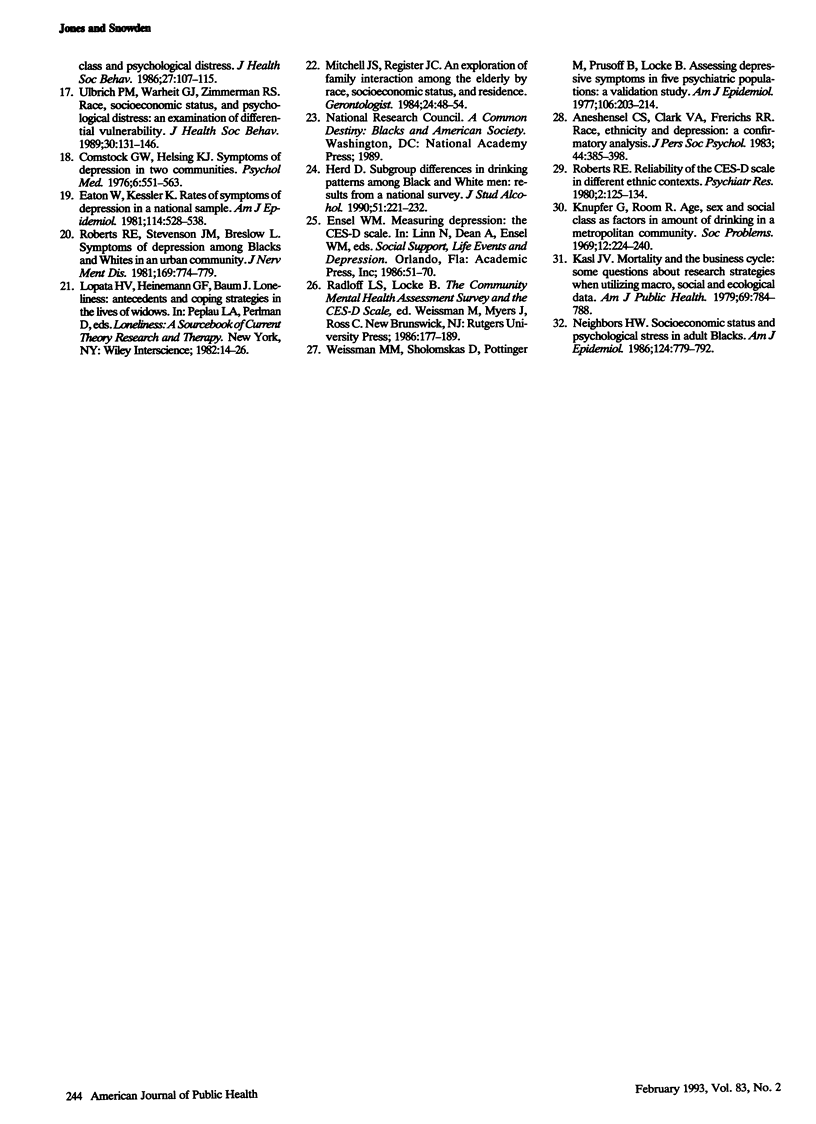Abstract
OBJECTIVES. We sought to examine relationships between sociodemographic indicators of risk and depression symptoms within the Black and White populations. METHODS. In a national probability sample, differences in sex, age, marital status, religion, social class, employment status, urbanicity, and region were evaluated against a Center for Epidemiological Studies Depression Scale score of 16 or greater. Risk factors were identified within the two populations and compared between them. RESULTS. For both races, females were at greater risk for depression than males, and respondents who were formerly married or separated were at greater risk than those who were currently married. Major differences in patterns of risk were also found between the races. Blacks who were 30 to 39 years of age, belonged to non-Western religious groups, and lived in the West were at greater risk than comparable Whites. Blacks who were widowed, members of the middle and lower-middle class, and unemployed were at less risk. CONCLUSIONS. Similarities and differences in patterns of risk were evident. The nature of the differences suggests important divergence in sociocultural and economic experience.
Full text
PDF




Selected References
These references are in PubMed. This may not be the complete list of references from this article.
- Aneshensel C. S., Clark V. A., Frerichs R. R. Race, ethnicity, and depression: a confirmatory analysis. J Pers Soc Psychol. 1983 Feb;44(2):385–398. doi: 10.1037//0022-3514.44.2.385. [DOI] [PubMed] [Google Scholar]
- Carr L. G., Krause N. Social status, psychiatric symptomatology, and response bias. J Health Soc Behav. 1978 Mar;19(1):86–91. [PubMed] [Google Scholar]
- Comstock G. W., Helsing K. J. Symptoms of depression in two communities. Psychol Med. 1976 Nov;6(4):551–563. doi: 10.1017/s0033291700018171. [DOI] [PubMed] [Google Scholar]
- Eaton W. W., Kessler L. G. Rates of symptoms of depression in a national sample. Am J Epidemiol. 1981 Oct;114(4):528–538. doi: 10.1093/oxfordjournals.aje.a113218. [DOI] [PubMed] [Google Scholar]
- Frerichs R. R., Aneshensel C. S., Clark V. A. Prevalence of depression in Los Angeles County. Am J Epidemiol. 1981 Jun;113(6):691–699. doi: 10.1093/oxfordjournals.aje.a113149. [DOI] [PubMed] [Google Scholar]
- Herd D. Subgroup differences in drinking patterns among black and white men: results from a national survey. J Stud Alcohol. 1990 May;51(3):221–232. doi: 10.15288/jsa.1990.51.221. [DOI] [PubMed] [Google Scholar]
- Ilfeld F. W., Jr Psychologic status of community residents along major demographic dimensions. Arch Gen Psychiatry. 1978 Jun;35(6):716–724. doi: 10.1001/archpsyc.1978.01770300058006. [DOI] [PubMed] [Google Scholar]
- Kaplan G. A., Roberts R. E., Camacho T. C., Coyne J. C. Psychosocial predictors of depression. Prospective evidence from the human population laboratory studies. Am J Epidemiol. 1987 Feb;125(2):206–220. doi: 10.1093/oxfordjournals.aje.a114521. [DOI] [PubMed] [Google Scholar]
- Kasl S. V. Mortality and the business cycle: some questions about research strategies when utilizing macro-social and ecological data. Am J Public Health. 1979 Aug;69(8):784–788. doi: 10.2105/ajph.69.8.784. [DOI] [PMC free article] [PubMed] [Google Scholar]
- Kessler R. C., Neighbors H. W. A new perspective on the relationships among race, social class, and psychological distress. J Health Soc Behav. 1986 Jun;27(2):107–115. [PubMed] [Google Scholar]
- Mirowsky J., 2nd, Ross C. E. Minority status, ethnic culture, and distress: a comparison of Blacks, Whites, Mexicans, and Mexican Americans. AJS. 1980 Nov;86(3):479–495. doi: 10.1086/227277. [DOI] [PubMed] [Google Scholar]
- Mitchell J., Register J. C. An exploration of family interaction with the elderly by race, socioeconomic status, and residence. Gerontologist. 1984 Feb;24(1):48–54. doi: 10.1093/geront/24.1.48. [DOI] [PubMed] [Google Scholar]
- Neff J. A. Race differences in psychological distress: the effects of SES, urbanicity, and measurement strategy. Am J Community Psychol. 1984 Jun;12(3):337–351. doi: 10.1007/BF00896754. [DOI] [PubMed] [Google Scholar]
- Neighbors H. W. Socioeconomic status and psychologic distress in adult blacks. Am J Epidemiol. 1986 Nov;124(5):779–793. doi: 10.1093/oxfordjournals.aje.a114454. [DOI] [PubMed] [Google Scholar]
- Neighbors H. W. The distribution of psychiatric morbidity in black Americans: a review and suggestions for research. Community Ment Health J. 1984 Fall;20(3):169–181. doi: 10.1007/BF00808105. [DOI] [PubMed] [Google Scholar]
- Roberts R. E. Reliability of the CES-D Scale in different ethnic contexts. Psychiatry Res. 1980 May;2(2):125–134. doi: 10.1016/0165-1781(80)90069-4. [DOI] [PubMed] [Google Scholar]
- Roberts R. E., Stevenson J. M., Breslow L. Symptoms of depression among blacks and whites in an urban community. J Nerv Ment Dis. 1981 Dec;169(12):774–779. doi: 10.1097/00005053-198112000-00005. [DOI] [PubMed] [Google Scholar]
- Somervell P. D., Leaf P. J., Weissman M. M., Blazer D. G., Bruce M. L. The prevalence of major depression in black and white adults in five United States communities. Am J Epidemiol. 1989 Oct;130(4):725–735. doi: 10.1093/oxfordjournals.aje.a115394. [DOI] [PubMed] [Google Scholar]
- Ulbrich P. M., Warheit G. J., Zimmerman R. S. Race, socioeconomic status, and psychological distress: an examination of differential vulnerability. J Health Soc Behav. 1989 Mar;30(1):131–146. [PubMed] [Google Scholar]
- Vernon S. W., Roberts R. E. Use of the SADS-RDC in a tri-ethnic community survey. Arch Gen Psychiatry. 1982 Jan;39(1):47–52. doi: 10.1001/archpsyc.1982.04290010025004. [DOI] [PubMed] [Google Scholar]
- Warheit G. J., Holzer C. E., 3rd, Arey S. A. Race and mental illness: an epidemiologic update. J Health Soc Behav. 1975 Sep;16(3):243–256. [PubMed] [Google Scholar]
- Warheit G. J., Holzer C. E., 3rd, Schwab J. J. An analysis of social class and racial differences in depressive symptomatology: a community study. J Health Soc Behav. 1973 Dec;14(4):291–299. [PubMed] [Google Scholar]
- Weissman M. M., Myers J. K. Affective disorders in a US urban community: the use of research diagnostic criteria in an epidemiological survey. Arch Gen Psychiatry. 1978 Nov;35(11):1304–1311. doi: 10.1001/archpsyc.1978.01770350030002. [DOI] [PubMed] [Google Scholar]
- Weissman M. M., Sholomskas D., Pottenger M., Prusoff B. A., Locke B. Z. Assessing depressive symptoms in five psychiatric populations: a validation study. Am J Epidemiol. 1977 Sep;106(3):203–214. doi: 10.1093/oxfordjournals.aje.a112455. [DOI] [PubMed] [Google Scholar]
- Yancey W. L., Rigsby L., McCarthy J. D. Social position and self-evaluation: the relative importance of race. AJS. 1972 Sep;78(2):338–359. doi: 10.1086/225328. [DOI] [PubMed] [Google Scholar]


